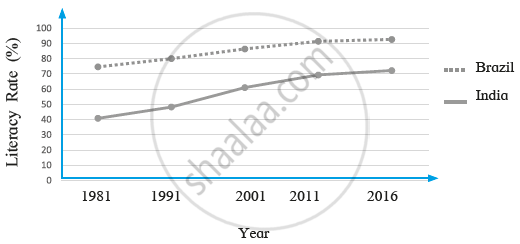Advertisements
Advertisements
प्रश्न
- Compare and classify the population densities shown in the squares ‘a’ and
‘b’ representing 1 sq.km of area. - If in figure B, one sign = 100, then what will be the sex ratio?
(a)
(b)
उत्तर
The density of population in figure (a) is less than the density of population in figure (b). Thus, figure (a) shows sparse population while figure (b) shows dense population.
Given that, one sign = 100 persons.
Since, there are 10 female signs, there are:
10 × 100 = 1000 females
Since, there are 8 male signs, there are:
8 × 100 = 800 males
If number of males = 1000,
then number of females =?
∴ Sex ratio = `1000 xx 1000/800` = 1250
∴ The sex ratio in this case is favourable.
APPEARS IN
संबंधित प्रश्न
Answer the following in detail.
Explain - The growth rate of population in India is decreasing but population is increasing.
The average life expectancy in India is increasing.
Read the following graph and answer the questions
India and Brazil Literacy Rate (%)

i) What was the literacy rate in Brazil in 2001?
ii) In which decade did the literacy rate increase the most in India?
iii) What is the difference between the literacy rates of India and Brazil in 1991?
iv) By how much has the literacy rate increased in India between 1981- 2016?
v) How much is the interval generally used in the graph?
vi) What conclusions can you draw from the graph regarding the literacy rates of India and Brazil?
With the help of given statistical data prepare a simple bar graph and answer the following questions:
India – Trend of Urbanisation (1961-2011)
| Year | Percentage of Urban Population |
| 1961 | 18.0 |
| 1971 | 18.2 |
| 1981 | 23.3 |
| 1991 | 25.7 |
| 2001 | 27.8 |
| 2011 | 31.2 |
(1) What is the interval of the data?
(2) Which decade shows slow rate of urbanisation?
(3) Which decade shows high rate of urbanisation?
Is the following sentence right or wrong? Correct the wrong one.
The life expectancy of Indians is decreasing.
Explain the similarities and differences between the population distribution in Brazil and India.
What could be the reasons of lower sex ratio in any region?
What should be done so that our manpower is utilized properly, sex ratio improves and population growth is controlled? Write two to three sentences on each.
Observe the following graph and answer the questions given below-
Brazil- % of population (2016)

- Which type of graph is this?
- Which age group has the highest population?
- Write class interval of age groups given on Y-axis.
- Whose number is more in males and females of age above 60?
- How much percent of females are found in age group of 55 to 59 years?
- After which age group is the decrease in population found?
Prepare a simple bar graph with the help of given statistical information and answer the questions given below-
Brazil-life expectancy
| Years | Life expectancy |
| 1960 | 54 |
| 1970 | 59 |
| 1980 | 61 |
| 1990 | 65 |
| 2000 | 70 |
| 2010 | 73 |
| 2016 | 75 |
Questions-
- What is the interval of years in the data?
- What is the difference in life expectancy of 1960 and 2016?
- Write five sentences about the analysis of graph.
